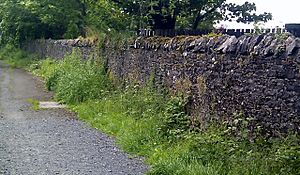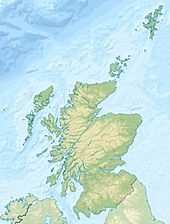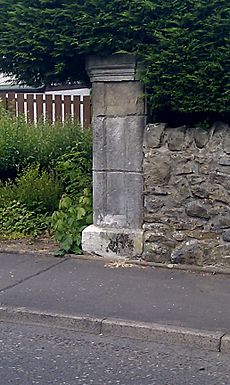Lands of Morishill facts for kids
Quick facts for kids Lands of Morishill |
|
|---|---|
| Beith, North Ayrshire, Scotland UK |
|

A section of the old Morishill boundary wall.
|
|
| Coordinates | 55°44′47″N 4°38′36″W / 55.7464°N 4.6432°W |
| Grid reference | NS 34186 53505 |
| Type | Laird's House |
| Site information | |
| Controlled by | Montgomerie |
| Open to the public |
Yes |
| Condition | Demolished |
| Site history | |
| Built | 17th century |
| Built by | Shedden family |
| Materials | Stone |
The Lands of Morishill (also spelled Morrishill, Moorishill, or Moricehill) were an important area near Beith, Scotland. They were part of a larger region known as the Barony of Beith. The name might have come from "shielings," which were small huts used by shepherds in the summer.
Contents
History of Morishill Lands
In the early 1600s, a person named Robert Peibles owned parts of Morishill. Later, in 1637, James and Janet Stewart held the land. By 1748, the Adam family had owned Morishill for many years. They got the land when Henry Adam married Margaret Stewart, whose father was John Stewart of Morishill.
A man named Robert Shedden, who was a successful merchant, bought the property from William Adam in 1748. Robert Shedden had made his money in Virginia, America. William Adam had faced difficulties managing the lands, so he decided to sell them. Robert Shedden also bought other nearby lands, like Longcroft and Hillhead.
James Dobie, a local historian, thought the name 'Morishill' came from 'Moreishiels.' He believed this referred to the large temporary homes that shepherds used to build there in the summer.
Owners of Morishill
After the Adam family, the Shedden family became the owners. Robert Shedden married Margaret Simson and later Elizabeth Moore. He had seven children. When he died in 1759, his son John Shedden inherited the property in 1760. John also worked as a merchant abroad before returning to Morishill. He married twice and had six children. He passed away at Morishill in 1833.
Alexander Shedden took over Morishill in 1833. He also inherited the Willowyard Estate in 1842. Alexander married Jessie Glasgow and had a daughter named Jessie Caldwell Shedden. He later married Martha Wilson. When Alexander died in 1867, his daughter Jessie inherited Morishill and other estates. Sadly, Jessie died young at age 27. The property then went to Mrs. Shedden-Dobie, and later to her son, John Shedden-Dobie.
In 1938, Colonel and Mrs. Hope Murray lived at Morishill.
The Story of James Montgomery
One important event connected to Morishill involved a man named James Montgomery. He was an enslaved person who sought his freedom in Scotland. Robert Shedden had bought Montgomery in Virginia in 1750.
Montgomery was baptized as 'Jamie Montgomery' by a minister named John Witherspoon in Beith. This was unusual because slave owners often did not allow enslaved people to be baptized or to use a Christian name and surname. Shedden was unhappy about this, believing it was a way for Montgomery to try and gain his freedom.
Montgomery managed to escape in 1756 while being taken to a ship. He traveled to Edinburgh, where he was recognized and placed in the tolbooth (a type of old prison). Shedden wanted Montgomery to be returned to him. He had even trained Montgomery as a joiner, which would make him more valuable.
Montgomery became ill and sadly died in the Edinburgh tolbooth before his case could be finished. This case was one of the first in Scotland where an enslaved person tried to win their freedom in court.
Morishill House and Gardens
After spending time working as a merchant, John Shedden returned to Morishill and made many improvements. In the 1830s, Alexander Shedden also worked on the old house and added a gatehouse and new gates. He greatly improved the gardens, which eventually covered about 14 acres. By 1842, a new house was finished. It had a unique two-story, eight-sided tower. A marshy area was turned into a beautiful lake with three islands.
In the 1870s, a new road was built to the stables. By 1888, the original house was changed into a garden feature, covered in ivy. This old house had been updated many times over the years and was later used as living quarters for a coachman. It had a special stone from 1752 that celebrated the marriage of Robert Shedden and Margaret Simson. Another stone from 1887 showed the initials 'J.S.-D'. The estate also had a summerhouse, a dovecote (a small building for pigeons), and a walled garden. A rookery, a place where rooks (birds) nest, was created by tying bundles of sticks in the trees.
A special feature in the gardens was a copy of a tall, decorative part from a monument in Largs. This copy was made by a local sculptor from Beith. It stood on a wall connecting the house to the laundry building.
In 1865, the lands of Morishill covered about 272 acres (110 hectares).
The main house was taken down in the early 1980s. A new housing area called Morishill Manor was built on the site. Many of the old trees were saved and can still be seen there today.
Curling at Morishill
An artificial curling rink was built at Morishill for Alexander Shedden. This allowed him to play curling even in the summer! They used a special ball for this game, which was about 10 inches (25 cm) wide and weighed 23 pounds (10 kg). It was made of a hard wood called lignum vitae and covered in copper.
In winter, people used the Morishill 'Pleasure pond,' also known as 'Beith Loch,' for curling. In 1892, a newspaper called Glasgow Herald reported a curling match between teams from Beith and Morishill. The Beith Morishill Curling Club still exists and plays at the Greenacres Curling Rink.



